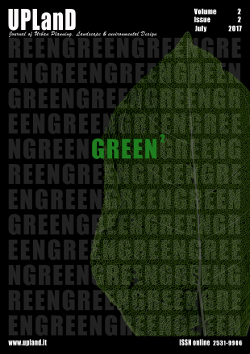Indexing the Human-Nature Relationship in Cities
Main Article Content
Abstract
Since the globalization of the world’s economy, there has been a surge in studies ranking international cities by quantitative indices. This paper examines various city indices and identifies the transition from an economy-centric approach towards a sustainability-oriented approach through the lens of those contributing variables used in different indices. The paper then introduces a new Biophilic City Index as a way to examine the human-nature relationship, i.e. biophilia, in cities. It is structured at three different levels: from nature service to ecological integrity to human-nature interaction. This index enriches existing city indices and encourages city planners and policy-makers to make cities more biophilic.
Downloads
Article Details

This work is licensed under a Creative Commons Attribution-NonCommercial-NoDerivatives 4.0 International License.
Authors who publish with this journal agree to the following terms:- Authors retain copyright and grant the journal right of first publication with the work simultaneously licensed under a Creative Commons Attribution License that allows others to share the work with an acknowledgement of the work's authorship and initial publication in this journal.
- Authors are able to enter into separate, additional contractual arrangements for the non-exclusive distribution of the journal's published version of the work (e.g., post it to an institutional repository or publish it in a book), with an acknowledgement of its initial publication in this journal.
- Authors are permitted and encouraged to post their work online (e.g., in institutional repositories or on their website) prior to and during the submission process, as it can lead to productive exchanges, as well as earlier and greater citation of published work (See The Effect of Open Access).
References
Barnes, T. G., & Adams, L. (1999). A guide to urban habitat conservation planning. Cooperative Extension Service. University of Kentucky, College of Agriculture.
Beatley, T. (1999). Green Urbanism: Learning From European Cities (Tuttle edition). Washington, DC: Island Press.
Beatley, T. (2010). Biophilic Cities: Integrating Nature into Urban Design and Planning. Washington, DC: Island Press.
Brookfield, H. (1984). Population development and environmental relations in planning in Eastern Fiji, and the Eastern Caribbean: MAB methodology and the problems of change through time. Presented at the Ecology in Practice: Establishing a Scientific Basis for Land Management, s.e. Retrieved from http://bases.bireme.br/cgi-bin/wxislind.exe/iah/online/?IsisScript=iah/iah.xis
Clark, G. (2011). The Business of Cities. Retrieved from http://thebusinessofcities.com/wp-content/uploads/2014/07/60551428-The-Business-of-Cities-Greg-Clark-Main-Paper-June-2011.pdf
Cohen, R. B., Dear, M., & Scott, A. J. (1981). The new international division of labor, multinational corporations and urban hierarchy. London: Methuen.
Friedmann, J. (1985). The world city hypothesis. Los Angeles: Graduate School of Architecture and Urban Planning, University of California, Los Angeles.
Hamilton, D. K., & Watkins, D. H. (2009). Evidence-Based Design for Multiple Building Types. John Wiley & Sons.
Harris, R. J., & Reed, J. M. (2002). Behavioral barriers to non-migratory movements of birds. Annales Zoologici Fennici, 39(4), 275–290.
Hashimoto, H. (2008). Connectivity Analyses of Avifauna in urban areas. In S.-K. Hong, N. Nakagoshi, B. Fu, & Y. Morimoto (Eds.), Landscape Ecological Applications in Man-Influenced Areas (pp. 479–488). Springer Netherlands. https://doi.org/10.1007/1-4020-5488-2_28
Ignatieva, M., & Ahrné, K. (2013). Biodiverse green infrastructure for the 21st century: from “green desert” of lawns to biophilic cities. Journal of Architecture and Urbanism, 37(1), 1–9.
Institute for Urban Strategies. (2011). Global Power City Index 2011. Retrieved May 28, 2016, from http://www.mori-m-foundation.or.jp/english/research/project/6/pdf/GPCI2011_English.pdf
Jokimäki, J., Kaisanlahti-Jokimäki, M.-L., Suhonen, J., Clergeau, P., Pautasso, M., & Fernández-Juricic, E. (2011). Merging wildlife community ecology with animal behavioral ecology for a better urban landscape planning. Landscape and Urban Planning, 100(4), 383–385. https://doi.org/10.1016/j.landurbplan.2011.02.001
Kellert, S. R., Heerwagen, J., & Mador, M. (2008). Biophilic Design: The Theory, Science, and Practice of Bringing Buildings to Life (1 edition). Hoboken, N.J: Wiley.
Lehmann, S. (2010). Green Urbanism: Formulating a Series of Holistic Principles. S.A.P.I.EN.S, (3.2). Retrieved from http://sapiens.revues.org/1057
McGarigal, K., & Marks, B. J. (1995). Spatial pattern analysis program for quantifying landscape structure. Gen. Tech. Rep. PNW-GTR-351. US Department of Agriculture, Forest Service, Pacific Northwest Research Station.
Mostafavi, M., & Doherty, G. (2010). Ecological urbanism. Lars Müller Publishers Baden.
Neel, M. C., McGarigal, K., & Cushman, S. A. (2004). Behavior of class-level landscape metrics across gradients of class aggregation and area. Landscape Ecology, 19(4), 435–455.
Pickett, S. T. A., Cadenasso, M. L., Grove, J. M., Nilon, C. H., Pouyat, R. V., Zipperer, W. C., & Costanza, R. (2008). Urban Ecological Systems: Linking Terrestrial Ecological, Physical, and Socioeconomic Components of Metropolitan Areas. In J. M. Marzluff, E. Shulenberger, W. Endlicher, M. Alberti, G. Bradley, C. Ryan, … C. ZumBrunnen (Eds.), Urban Ecology (pp. 99–122). Springer US. https://doi.org/10.1007/978-0-387-73412-5_7
Register, R. (1987). Ecocity Berkeley: Building Cities for a Healthy Future. North Atlantic Books.
Sassen, S. (1991). The Global City: New York, London, Tokyo. Princeton University Press.
Steiner, F. (2011). Landscape ecological urbanism: Origins and trajectories. Landscape and Urban Planning, 100(4), 333–337. https://doi.org/10.1016/j.landurbplan.2011.01.020
Taylor, Z. (2011). “Lies, damned lies, and statistics”: a critical examination of city ranking studies. Metapolis Consulting. Retrieved from http://site.ebrary.com/id/10813183
Wilson, E. O. (1986). Biophilia (Reprint edition). Cambridge, Mass.: Harvard University Press.

